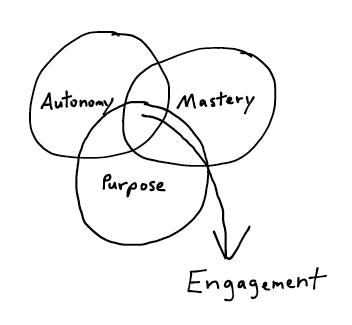Tapping the Trinity of Instrinsic Motivation
 Recently I wrote about why you shouldn’t rely on Extrinsic Motivation to drive lasting engagement. So if that’s off the table… what CAN you do? What’s the secret?
Recently I wrote about why you shouldn’t rely on Extrinsic Motivation to drive lasting engagement. So if that’s off the table… what CAN you do? What’s the secret?
Simple. To create a truly compelling experience, tap into the Trinity of Intrinsic Motivation: Autonomy, Mastery, and Purpose. This three-part framework emerged during the 1970s as Self-Determination Theory and was recently re-popularized in Dan Pink’s ‘Drive’ in the context of workplace motivation, and in Rigby and Ryan’s ‘Glued to Games’ exploring why digital games are so compelling. Collectively, this research shows that extrinsic metrics and rewards can be very effective at getting people to complete simple tasks – but often backfire and lower effectiveness for creative tasks that require out-of-the-box thinking. And watch out – extrinsic rewards can de-value pleasurable tasks like reading or drawing. In this famous study, kids who loved reading were rewarded for reading.. and after that experience, they stopped reading for pleasure.
Try tapping into these three motivations in your core design – then support them with extrinsic tracking and rewards. You’ll get a better, more sustainable outcome.
Autonomy: Meaningful Choices Within Interesting Constraints
Autonomy is all about the feeling of controlling your own destiny. In a game, app or service, this boils down to how and when you offer choices to the player. [tweetable]Great games offer meaningful choices within interesting constraints. [/tweetable] Think of Settlers of Catan, World of Warcraft, Minecraft, even Kickstarter – all systems that can be explored and mastered by following your interests and making meaningful choices.
Mastery: building competence and skill through feedback and challenges
Mastery taps into the feeling of getting better at something. Games offer the player a set of actions and choices within a constrained, rule-based environment. In a great game, mastering those rules is deeply pleasurable. The lack of anything to master is often why simple gamification often fails. PB (point, badges, leaderboards) isn’t compelling unless you’re improving along a dimension that’s meaningful to you. Ask yourself: How can my player kick ass? What skills is she building? How can I make that process pleasurable and keep her motivated?
Purpose: connecting with something greater than yourself
Purpose is about the feeling of connection and relatedness – with other people, with a shared cause, with something greater than yourself. Purpose is often communicated through storytelling – and in great games and products, the most powerful story is happening inside player’s head – the story of how playing that game or product is making her better, stronger, more powerful, more skillful, more connected to the issues and people she cares about. This “heroic” story is enabled by the basic mechanics and social actions within your game or product – so make sure they’re aligned with the core message you want to convey.
Créer la rétention avec la motivation intrinsèque | el Gamificator
March 17, 2014 @ 6:40 am
[…] Jo Kim propose une méthode pour créer la motivation intrinsèque chez un utilisateur en adaptant la théorie de […]
Amy Jo Kim | vinitadhondiyal
April 13, 2014 @ 7:15 am
[…] Amy Jo Kim […]